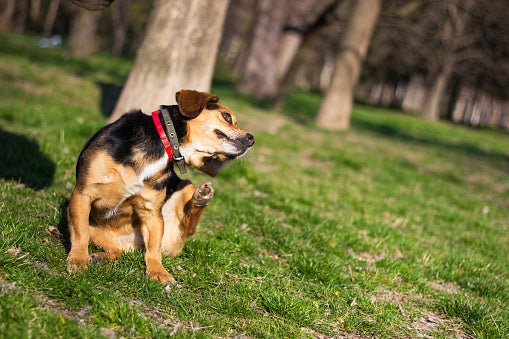Natural remedies for hot spots on dogs
May 30, 2023

Published: June 2021 | Updated: May 2023
Hot spots are one of the most common skin problems in dogs, often becoming the most problematic in the summer months. They seem to arise out of nowhere, causing pain, itchiness, and annoyance to our dogs. Fortunately, they can be managed and sometimes prevented when treated properly.
What Are Hot Spots on Dogs?
Hot spots, also known as acute moist dermatitis, are areas of skin that become inflamed and infected by bacteria. They generally begin as a small reddened area that may look like an insect bite. But, unlike an insect bite, they progress rapidly into an oozing, painful sore.
When skin is broken, a mild itch soon turns into a serious medical issue. Increased licking, scratching, and biting result in self-inflicted lesions on our dogs.
The spots are hard for our dogs to resist, so they don't scab over. That would be hard for us, as humans, to do. Think about it. If you have an itch, do you scratch it? What if your skin was so itchy it was painful NOT to scratch and a little bit of scratching provided you even the smallest bit of comfort?
This is why hot spots on dogs rarely clear up on their own when left untreated and can rapidly turn into an alarming issue, such as infected hot spots on dogs.
What Does a Hot Spot Look Like on a Dog?
If you have any concerns regarding your dog, you should see your veterinarian. Typically, redness, edema, and hair loss occur in the beginning stages of hot spot development. They are most typically found on the head, limbs, and hips.
The best time to see your veterinarian would be when you notice a reddened area, but of course that's not always easy to notice if your dog has a long coat. You will; however, notice excessive scratching, itching, and/or licking and can take a look to see what your dog is gnawing at. If you suspect your dog is developing a hot spot, contact your veterinarian to prevent lesions from forming.
What Causes Hot Spots on Dogs?
Although they seem to magically appear, hotspots are often triggered by scratching, licking, or chewing the reddened area excessively. The trauma caused by the excessive attention to the area results in inflammation and bacterial infections. Of course this doesn't prevent the skin from being just as irritated, so our dogs will often continue digging at the area worsening the lesion.
Common causes of excessive itching, scratching, and chewing include:
- Parasite infestation
- Flea allergy dermatitis
- Food allergies
- Atopic Dermatitis
- Ear infections
- Skin infections
- Anal sac disease
- Contact irritants from the environment
- Stress
- Boredom
- A dirty coat
- Moisture trapped from swimming or bathing
Preventing Skin Hot Spots on Dogs
The key to preventing future hot spots is identifying and addressing the underlying cause. If the underlying cause isn't determined, hot spots are likely to recur continuously.
There are some breeds who are more prone to hot spots than others due to their thick coats. These breeds include, but aren't limited to, Saint Bernards, German Shepherds, Labrador Retrievers, and Rottweilers.
Hot spots are also most likely to occur during the summer months due to warm weather combined with high humidity. Dogs who swim frequently or are continuously in inclement weather are also at higher risk.
How to Treat Hot Spots on Dogs
Although waiting for the hot spot to clear may be tempting, waiting just makes the situation worse. The cause of the dog hot spot will have to be identified in order to treat it and to prevent it from recurring.
During the exam, your veterinarian may recommend your dog have more tests done to determine the cause. Once the cause of your dog's itching has been diagnosed, your veterinarian will determine the right method of treatment.
Most dogs have an improved condition once the hot area is treated. Often, the hot spot resolves in 3–7 days after treatment begins.
Treatment varies but may include:
- Clipping the hair on and around the affected area
- Cleaning the affected area with gentle antiseptic solutions (like chlorhexidine)
- Topical or oral antibiotics to treat secondary bacterial infections
- Topical or oral steroids to control inflammation and relieve itchiness
- Medicated wipes to gently clean the affected area
- Applying an Elizabethan collar (cone) to prevent continued scratching and irritation
Before you take your dog to the vet, you may be tempted to do something for her to relieve her itchiness until you make it to the appointment.
Human drugs and ointments such as Neosporin, hydrocortisone, and Vaseline should NOT be utilized. Avoid topical lotions and ointments, as these tend to make dogs lick the area even more.
If you want to help, you can begin the process by carefully clipping the hair around the affected area and placing the Elizabethan collar on her to prevent further damage. You can also wash her with antibacterial shampoo to help relieve some of the symptoms (if it’s not to the point of a lesion) until your veterinary appointment.
The Bottom Line
Prevention is crucial in this situation. Preventing hot spots is far easier than treating them, so make sure to regularly bathe your dog, provide her with a well-balanced diet, and give her the proper flea and tick medicine.
Remember, if you do suspect your dog has a hot spot, consult with your veterinarian as soon as possible to prevent a lesion from forming. If you notice a tender, reddened area, it doesn’t hurt to be safe rather than sorry.
→Highly Recommended: The daily supplement proven to help balance your dog’s skin and coat health through the powerful gut microbiome←
